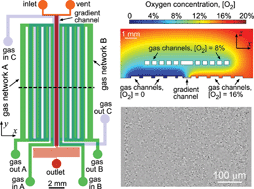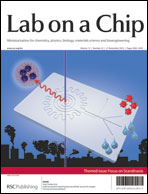Studies of bacterial aerotaxis in a microfluidic device†
Abstract
Aerotaxis, the directional motion of bacteria in gradients of oxygen, was discovered in the late 19th century and has since been reported in a variety of bacterial species. Nevertheless, quantitative studies of aerotaxis have been complicated by the lack of tools for generation of stable gradients of oxygen concentration, [O2]. Here we report a series of experiments on aerotaxis of Escherichia coli in a specially built experimental setup consisting of a computer-controlled gas mixer and a two-layer microfluidic device made of polydimethylsiloxane (PDMS). The setup enables generation of a variety of stable linear profiles of [O2] across a long gradient channel, with characteristic [O2] ranging from aerobic to microaerobic conditions. A suspension of E. coli cells is perfused through the gradient channel at a low speed, allowing cells enough time to explore the [O2] gradient, and the distribution of cells across the gradient channel is analyzed near the channel outlet at a throughput of >105 cells per hour. Aerotaxis experiments are performed in [O2] gradients with identical logarithmic slopes and varying mean concentrations, as well as in gradients with identical mean concentrations and varying slopes. Experiments in gradients with [O2] ranging from 0 to ∼11.5% indicate that, in contrast to some previous reports, E. coli cells do not congregate at some intermediate level of [O2], but rather


 Please wait while we load your content...
Please wait while we load your content...